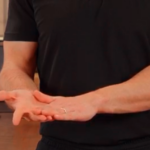Posture Correction | Early Intervention Ergonomics
What is the Posture Correction Exercise?
This is a dynamic active stretch to correct the top two poor posture habits of forward head and rounded shoulders. Proper posturing of the neck and shoulders opens the vascular and nervous system to replenish nutrients and re-oxygenate upper extremity. Perform this stretch to give your body rest when performing forceful gripping, repetitive gripping, awkward or sustained postures of the elbow, forearm, wrist, and hand to prevent common disorders such as tennis elbow, golfer’s elbow, carpal tunnel syndrome, trigger finger, tendinitis, tendinosis, and muscle strain.
The first step in the posture correction exercise is to put your hands across your forehead. The next thing I want you to do is take a good deep breath and as you exhale, pull the hands apart away from your head, squeezing the shoulder blades, rotating the palms away, pushing all the way out and down. Be sure to keep your chin tucked in while performing this exercise.
Early Intervention Benefits of this Exercise
The Posture Correction Exercise offers several early intervention health benefits for your posture and upper body:
- Posture Improvement: The shoulder blade squeeze helps counteract the forward rounding of the shoulders, which is a common issue due to poor posture and prolonged sitting. By strengthening the muscles that retract and stabilize the shoulder blades, such as the rhomboids and middle trapezius, this exercise promotes a more upright and aligned posture.
- Upper Back Strengthening: The posture correction stretch targets the muscles of the upper back, including the rhomboids, middle and lower trapezius, and rear deltoids. Regularly performing this exercise can help strengthen these muscles, improving their endurance and overall strength.
- Shoulder Stability: This exercise promotes better shoulder stability by engaging the muscles that control scapular movement. Strong and stable shoulder blades provide a solid foundation for optimal shoulder function, reducing the risk of shoulder injuries and improving overall upper body strength.
- Neck and Upper Back Tension Relief: It helps alleviate tension and discomfort in the neck and upper back region. By retracting the shoulder blades, it counteracts the forward head posture and tightness in the neck and upper trapezius muscles often associated with prolonged sitting or poor posture.
- Improved Breathing Mechanics: When your shoulder blades are properly aligned and engaged, it opens up the chest and allows for better expansion of the ribcage during breathing. This can enhance your breathing mechanics and increase the efficiency of your respiratory system.
It’s important to note that while the posture correction exercise offers these benefits, it should be performed in conjunction with a well-rounded exercise program that addresses overall posture, strength, and flexibility.
These early intervention exercises are to improve overall health and fitness and reduce injuries.
If you have an injury or illness, consult with a health care professional before attempting.










